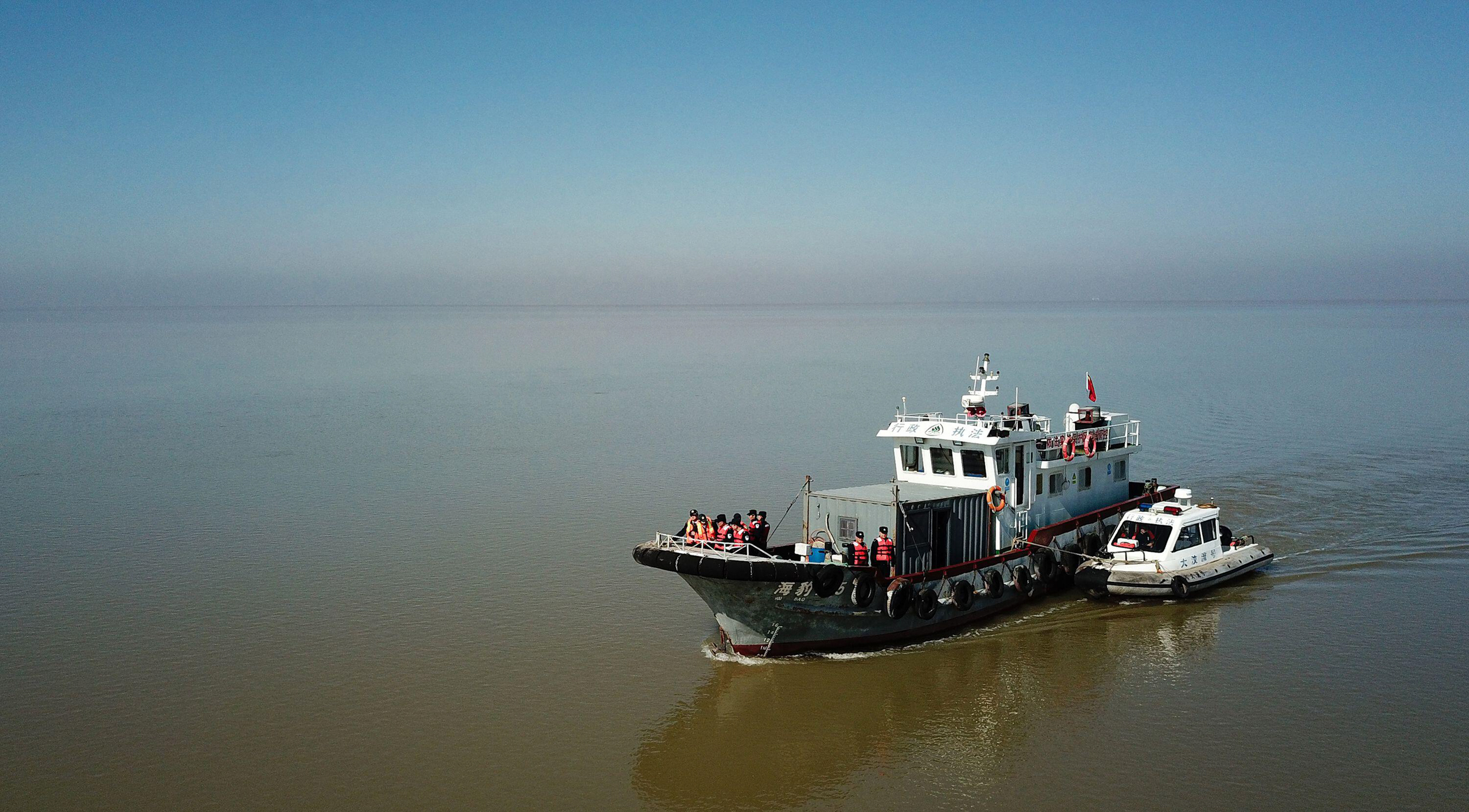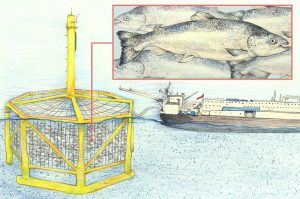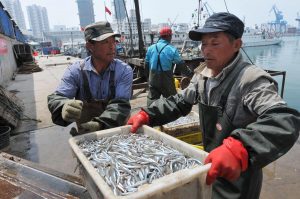In the small hours of an August morning in 2022, enforcement officers in Shanghai intercepted a speedboat at the Yangtze River estuary. On board, they found eight people engaged in illegal fishing, 91kg of blue crabs, and prohibited netting. It was later established that the speedboat was unregistered, with no official name, number, certification or homeport registration.
Such raids of unregistered vessels frequently make the news in China. Some are used for sleeping, catering or sand dredging. Of those vessels used for fishing, most act illegally. This is seriously disrupting fisheries management and driving the precipitous decline of inshore fish stocks.
Wei Zhou, who heads the oceans programme at Greenpeace East Asia, tells Dialogue Earth: “Reliable data is the basis for fisheries management, with fisheries agencies knowing the number of fishing vessels out there and the size of their catch … the presence of unregistered vessels clearly complicates the compilation of data on actual capacity and catch size. This undermines the work of fisheries management.”
Spurred by commercial gain
At a 2021 press conference, China’s Fisheries Administration director Liu Xinzhong said unregistered boats had long been the scourge of fisheries enforcement.
As early as 1987, China began restricting the numbers and engine sizes of fishing vessels. The fisheries law, which came into force at that time, required boats to have valid registration and inspection certificates, and a fishing licence. However, by 2003 the system had not been fully implemented in many coastal areas, because the grant support fishers needed to join an alternative industry had not been made available.
In the 1990s, the central government became alert to the overexploitation of fish stocks. The State Council decreed a crackdown on unregistered boats in 1994, seizing vessels and fining owners. That remains the core of fishery law enforcement efforts today.
Since 2017, more than 200,000 fishing vessels have been declared illegal and scrapped by the Ministry of Agriculture and Rural Affairs. However, fishers continue taking the risk in pursuit of commercial gain.
In July 2019, a reporter from Zhejiang Online joined enforcement officials in the eastern city of Wenzhou. They were investigating illegal activity during that year’s “closed season”. In the East China Sea, this fishing moratorium runs between May and September, to preserve and restore fish stocks. When asked why they broke the law, fishers pointed to higher prices during the closed season. A full supply chain was in place and dealers stood by for off-the-books orders – there was “no worry about not being able to sell”.
Enforcement officials told Zhejiang Online that most fishing craft active during the closed season – usually wooden boats or foam rafts – were unregistered. It only took poachers a day or two, with luck, to recoup the typical vessel construction cost of CNY 10,000-20,000 (USD 1,400-2,800).
Not only do most unregistered fishing vessels break the closed season’s moratorium, but they also fish with illegal, fine-mesh nets and practice electric pulse fishing. These actions have the potential to decimate stocks to the extent that properly registered vessels have “nothing left to catch” in coastal waters.
According to a 2021 Greenpeace report, large numbers of unregistered boats were operating covertly across China’s inland waterways and seas, often by night or in overlapping jurisdictions, where enforcement is intermittent. Some operators are even willing to chance their luck on the high seas, the report states. This all adds to the difficulty of on-the-spot enforcement.
Using tech to regulate fishing vessels
Promoting the standardised application of onboard technologies such as the Automatic Identification System (AIS) can enhance fisheries management, the Greenpeace report suggests.
AIS transmits any seaborne vessel’s ID, position, speed and course around the clock to onshore base stations, satellites, and all other in-range, AIS-equipped vessels.
Dialogue Earth consulted Nate Miller, head of applied research at the data-sharing NGO Global Fishing Watch. He says AIS was originally designed to aid navigation and prevent collisions, but it is increasingly used by authorities and NGOs to identify vessels that are fishing and monitor their activity.
What are purse seiners?
Purse seiners are fishing boats that use vertical, potentially kilometres-long nets (the “seine”) to surround fish. These nets are then pulled together (“pursed”) at the bottom to complete the catch.
Machine learning is now being used to process large amounts of AIS data, which feeds models that can differentiate between types of fishing vessels. A trawler, for example, will usually pass repeatedly over a relatively shallow area at intermediate speeds; a purse seiner may move in straight lines, then in tight circles as it deploys its net.
In the past few years, AIS data has played a part in multiple seaborne enforcement actions in China. Last year, enforcement officers in Guangdong used it to identify fishing boats via those tell-tale movements, which enabled patrols to conduct on-the-spot verification.
While AIS data is relatively accurate in most cases, information such as vessel names and route plans must be entered manually and can be altered. In 2021, the Work Safety Committee of the State Council discovered two instances of falsified AIS information during unannounced inspections. The crews said they had chosen to falsify information rather than switch off their AIS because they wanted it on for safety only, not for oversight.
In 2021, the Ministry of Agriculture and Rural Affairs demanded the rollout of AIS that incorporates ID cards in coastal provinces, following a successful pilot in Fujian province. Developed by the Chinese Academy of Fishery Sciences, the cards aim to prevent data tampering, destruction or deliberate disconnection. The academy claims these difficult-to-remove cards ensure their systems are online 99.7% of the time, compared with 30-40% for conventional equipment.
Miller points out that AIS still depends on ships transmitting information about their own position, however. If an unregistered vessel is not fitted with AIS or switches it off, other tools such as satellite imagery and radar come into play, supported by information from port authorities.
The fishery bureau in Xiangshan county has been using radar and CCTV to monitor its patch of the East China Sea since May 2019. The system scans the port’s waters every 2.5 seconds, checking the legality of inbound and outbound fishing vessels. It does this by comparing hull identification numbers, and BeiDou Navigation Satellite (BDS) and AIS data. It automatically alerts the police when an unregistered vessel is identified, boosting enforcement efficiency. As of 2021, the county had seized 285 unregistered vessels.
In Wei Zhou’s view, technology can indeed make enforcement more effective, but surveillance-led enforcement cannot fully resolve the problem of unregistered fishing vessels. She says systematic solutions are needed.
Rebuilding lives
The past decade has proven that ensuring fishers can access alternative sources of income is part of the solution to these problems.
In 2015, People’s Daily (the official state newspaper) interviewed Mr Zhang, a struggling ex-fisher in his 50s living in the coastal city of Ningbo, south of Shanghai. The lifelong fisher described how he had invested in building his own boat when the market was buoyant, before being forced to sell it during a market downturn. With no other assets or vocational skills, however, he had little choice but to continue fishing with an unregistered boat. That vessel was confiscated in 2014. A year later, Zhang was working part-time for CNY 2,000-3,000 (USD 270-415) a month – far less than a full-time member of China’s subsidised coastal fisheries workforce would hope to earn in 2015.
At the time, the then-deputy director of Xiangshan’s Marine and Fisheries Bureau warned there were few options besides the sea for those in under-resourced coastal areas. Owners of fishing boats in such areas tend to be older and have less transferrable labour skills, making it hard for them to switch industries. Fishery officials and experts said bespoke, targeted policies would be necessary if fishers were to be resettled in a fair and just manner.
Provinces and municipalities have been holding mass scrappage events for years, crushing unregistered vessels to send out a warning. But a 2018 study by Zhejiang Ocean University revealed a resurgence in active, unregistered craft in the province’s coastal areas. Such stubborn trends were chiefly attributed to fishers’ financial pressures.
Additionally, bans on fishing along the Yangtze River, imposed during the 2020s, have decommissioned more than 100,000 legally registered boats. This has had implications for the redeployment and relocation of more than 200,000 people; this issue has large, far-reaching impacts.
In early April, China’s Ministry of Human Resources and Social Security issued an update regarding the Yangtze River ban. It said by 2023, 154,000 of the impacted fishers who still had the ability and willingness to work had transferred to other jobs. However, local law enforcement continues to reveal unregistered vessels across the country, including along the Zhejiang and Guangdong coasts and the Yangtze this year.
The situation suggests that, while technology is helping to tackle unregistered fishing vessels, the pressures leading many to fish illegally in the first place need consideration.










